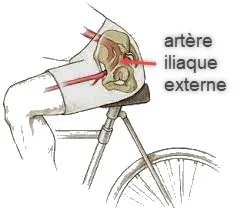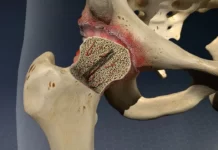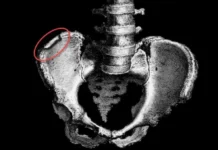Progressive iliac artery stenosis, known as iliac artery endofibrosis, is a little-recognized condition characterized by thickening of the intima of the iliac artery.
Introduction
Endofibrosis of the pelvic and thigh arteries in cyclists is a specific condition that can significantly affect the performance and well-being of athletes. This vascular condition, characterized by structural changes in the arteries, is particularly prevalent among professional cyclists, although other athletes can also be affected. Understanding aspects of this condition, from its causes to its clinical manifestations, is essential for appropriate management.
Endofibrosis mainly focuses on the external iliac, affecting up to 90% of cases. It is an exertional arteriopathy, which means that it often occurs in individuals engaged in intense and prolonged sporting activities. Professional cyclists are particularly prone to this condition, but it can also affect other groups, such as triathletes, long-distance runners, cycle tourists, and even fans of sports such as canoeing or rugby.
Unlike other vascular conditions such as arteriosclerosis, endofibrosis can be difficult to diagnose. Conventional imaging methods, such as CT angiography and arteriography, can sometimes fail to detect this condition, leading to delays in diagnosis. Symptoms in cyclists can be varied, ranging from heavy leg sensations to cramps, atypical pain and a feeling of tightness or tight shorts. These symptoms can have a significant impact on athletes’ sports performance and quality of life.
Classic signs of endofibrosis include reduction in the caliber of the arteries in the lower extremity, leading to decreased blood flow. This alteration can cause a variety of exercise symptoms, such as severe cramps, dead leg feeling, fatigue, edema, and even paresthesias and temporary paralysis. These manifestations can occur in apparently healthy and motivated athletes, making it crucial for practitioners to recognize potential signals of endofibrosis.
A common complication of endofibrosis is claudication when walking, which can signal thrombosis of the artery, leading to partial or total obstruction of the vessel. It is essential to emphasize that endofibrosis, although more common in cyclists, can affect other sporting groups and should be considered as a potential cause of ischemic symptoms in athletes.
The first documented description of endofibrosis was in 1984, highlighting how relatively recently this condition was recognized in the medical field. Since then, the understanding of endofibrosis has improved, but challenges remain in its diagnosis and management. Treatment approaches may include surgical procedures to correct vascular abnormalities and restore normal blood flow.
In conclusion, endofibrosis of the pelvic and thigh arteries in cyclists is a specific condition that can have important implications for health and athletic performance. Early recognition of symptoms and appropriate management are crucial to minimize the impact on athletes’ lives. Continued research in this area is necessary to improve diagnostic and treatment strategies, providing better prospects for athletes affected by this vascular condition.
Defining endofibrosis
Endofibrosis is a vascular condition characterized by structural changes in the arteries, particularly in the external iliac. This condition is often seen in athletes, particularly high-performance cyclists, although it can also affect other groups engaging in intense sporting activities. Changes in the arteries involve a thickening of the inner lining of blood vessels, generally induced by repeated and prolonged stresses associated with specific movements linked to certain sporting activities. Endofibrosis can cause the arteries to become narrower, compromising blood flow and causing various symptoms, such as cramps, heavy legs, and even limping when walking. This condition can be diagnosed using various imaging techniques, although its detection can sometimes pose challenges due to the resistance of some cases to conventional methods. Treatment for endofibrosis may involve surgical procedures to restore normal vascular function and relieve symptoms.

Causes
Endofibrosis is a medical condition characterized by abnormal thickening of the inner lining of the arteries, usually seen in the iliac arteries (arteries located in the pelvic region). The exact causes of endofibrosis are not always clear, but certain factors may be associated with this condition. Here are some things that could contribute to the development of iliac artery endofibrosis:
- Repetitive trauma: Endofibrosis of the iliac arteries has often been observed in people participating in cycling sports, particularly professional cyclists. The repetitive movement of the lower limbs while pedaling could contribute to irritation and thickening of the inner lining of the arteries.
- Genetic factors: Genetic predispositions may play a role in susceptibility to developing endofibrosis.
- High blood pressure: High blood pressure can contribute to changes in the lining of the arteries.
- Vascular microtrauma: Repetitive microtrauma to the arteries, due to constant and repeated movements, could contribute to the development of endofibrosis.
- Inflammation: Inflammatory processes in the arteries could promote the formation of fibrosis.
- Specific anatomy: Some individuals may have specific iliac artery anatomy that makes them more susceptible to endofibrosis.
Symptoms
Symptoms of iliac artery endofibrosis can vary from person to person, and some individuals may not have any symptoms. However, when symptoms do occur, they may include:
- Intermittent claudication: This is the most common symptom. This is pain, cramping, or muscle weakness in the hip, thigh, or buttock during physical exertion, usually while walking or cycling.
- Decreased sports performance: People who participate in sports activities, particularly cycling, may notice a decrease in their performance.
- Groin pain: Some people feel pain in the groin or lower abdomen area.
- Decreased or absent pulse: A healthcare professional may detect a diminished or absent pulse in the affected leg.
- Leg cooling: The affected leg may feel colder than the other.
- Muscle atrophy: A decrease in muscle mass in the affected leg may occur.
Pathophysiology
The pathophysiology of iliac artery endofibrosis involves structural changes in the inner lining of the arteries, particularly in the iliac arteries. Although specific aspects of the pathophysiology may vary, here is generally how this condition develops:
- Repetitive microtrauma: In people who participate in sporting activities, particularly cycling, the repetitive movement of the lower extremities, combined with pressure placed on the iliac arteries during pedaling, can lead to microtrauma to the artery walls.
- Inflammatory response: These microtraumas can trigger a local inflammatory response. Inflammation can cause changes in the structure of the endothelial cells that line the inside of arteries.
- Fibrosis Formation: In response to inflammation, there may be excessive proliferation of smooth muscle cells and collagen production, leading to fibrosis. The inner wall of the arteries thickens, reducing the diameter of the arterial lumen.
- Partial obstruction: Fibrosis causes a decrease in the elasticity of the arteries and can lead to partial obstruction of blood flow, particularly during physical exertion.
- Symptoms: Symptoms, such as intermittent claudication, occur when blood flow to the leg muscles is compromised during physical activity.
Diagnosis and Treatment
Diagnosis of iliac artery endofibrosis usually involves a combination of clinical examinations, medical imaging, and sometimes functional testing. Treatment depends on the severity of symptoms and the impact on the patient’s quality of life. Here is an overview of the diagnosis and treatment of endofibrosis:
Diagnostic
- Clinical Examination: A doctor may perform a physical examination to evaluate symptoms, such as intermittent claudication, decreased heartbeat, or other clinical signs.
- Medical Imaging: Imaging tests, such as Doppler ultrasound, magnetic resonance angiography (MRI), or computed tomography (CT) angiography, can be used to visualize the structure of the arteries and confirm the diagnosis.
- Functional Tests: Certain functional tests, such as the ankle-brachial blood pressure (ABI) test, can help assess the severity of arterial blockage.
Treatment
- Conservative Treatment:
- Modification of Activities: Avoid activities that trigger symptoms.
- Pain Management: Use of analgesic or anti-inflammatory medications.
- Lifestyle Modification:
- Reduction in Physical Activity: Reduce the intensity of activities that may worsen symptoms.
- Stopping Cycling: In some cases, a break from cycling may be recommended.
- Medical treatment :
- Anticoagulants: To prevent the formation of blood clots.
- Vasodilators: May be prescribed to improve blood flow.
- Surgery or Endovascular Intervention:
- Angioplasty and Stent Placement: To dilate the artery and maintain its patency.
- Endarterectomy: Surgical removal of the thickened fibrous layer of the artery.
- Post-Operative Management:
- Regular Medical Monitoring: To evaluate the effectiveness of treatment and monitor the progression of the disease.
- Rehabilitation: Physical rehabilitation program to improve muscle strength and function.
Conclusion
In conclusion, iliac artery endofibrosis is a condition characterized by abnormal thickening of the inner lining of the arteries, mainly seen in people participating in sports activities, especially cycling. Repetitive microtrauma induces an inflammatory response leading to fibrosis and partial obstruction of the arteries, causing symptoms such as intermittent claudication.
Diagnosis is based on a clinical examination, medical imaging tests and functional assessments. Treatment varies depending on the severity of symptoms and may include conservative approaches, lifestyle modifications, drug treatments, and, in more severe cases, surgical or endovascular interventions.
A multidisciplinary approach, involving healthcare professionals such as vascular surgeons, cardiologists and osteopaths, is essential to provide comprehensive care. Regular medical monitoring, physical rehabilitation and post-operative management are crucial to optimize results and improve the quality of life of patients with iliac artery endofibrosis. If symptoms are present, it is recommended to consult a healthcare professional for an accurate diagnosis and recommendations tailored to the individual case.
References
- Peach G, Schep G, Palfreeman R, Beard JD, Thompson MM, Hinchliffe RJ. Endofibrosis and kinking of the iliac arteries in athletes: a systematic review. Eur J Vasc Endovasc Surg. 2012;43(2):208–17. [ PubMed ] [ Google Scholar ]
- Schep G, Bender MH, van de Tempel G, Wijn PF, de Vries WR, Eikelboom BC. Detection and treatment of claudication due to functional iliac obstruction in top endurance athletes: a prospective study. Lancet. 2002;359(9305):466–73. [ PubMed ] [ Google Scholar ]
- Shalhub S, Zierler RE, Smith W, Olmsted K, Clowes AW. Vasospasm as a cause for claudication in athletes with external iliac endofibrosis. J Vasc Surg. 2013;58(1):105–11. [ PubMed ] [ Google Scholar ]
- Schep G, Kaandorp DW, Bender MH, Van Engeland S, Weerdenburg H, Titulaer BM, et al. Excessive length of iliac arteries in athletes with flow limitations measured by magnetic resonance angiography. Med Sci Sports Exercise 2002;34(3):385–93. [ PubMed ] [ Google Scholar ]
- Feugier P, Chevalier JM. Endofibrosis of the iliac arteries: an underestimated problem. Acta Chir Belg. 2004;104(6):635–40. [ PubMed ] [ Google Scholar ]
- Mosimann R, Walder J, Van Melle G. Stenotic intimal thickening of the external iliac artery: illness of the competitive cyclist? Report of two cases. Vasc Endovascular Surg. 1985;19(4):258–63. [ Google Scholar ]
- Bender MH, Schep G, de Vries WR, Hoogeveen AR, Wijn PF. Sports-related flow limitations in the iliac arteries in endurance athletes: aetiology, diagnosis, treatment and future developments. Sports Med. 2004;34(7):427–42. [ PubMed ] [ Google Scholar ]
- Abraham P, Saumet JL, Chevalier JM. External iliac artery endofibrosis in athletes. Sports Med. 1997;24(4):221–6. [ PubMed ] [ Google Scholar ]
- Schep G, Bender MH, Schmikli SL, Mosterd WL, Hammacher ER, Scheltinga M, et al. Recognizing vascular causes of leg complaints in endurance athletes. Part 2: the value of patient history, physical examination, cycling exercise test and echo-Doppler examination. Int J Sports Med. 2002;23(5):322–8. [ PubMed ] [ Google Scholar ]
- Rousselet MC, Saint-Andre JP, L’Hoste P, Enon B, Megret A, Chevalier JM. Stenotic intimal thickening of the external iliac artery in competitive cyclists. Um Pathol. 1990;21(5):524–9. [ PubMed ] [ Google Scholar ]


























